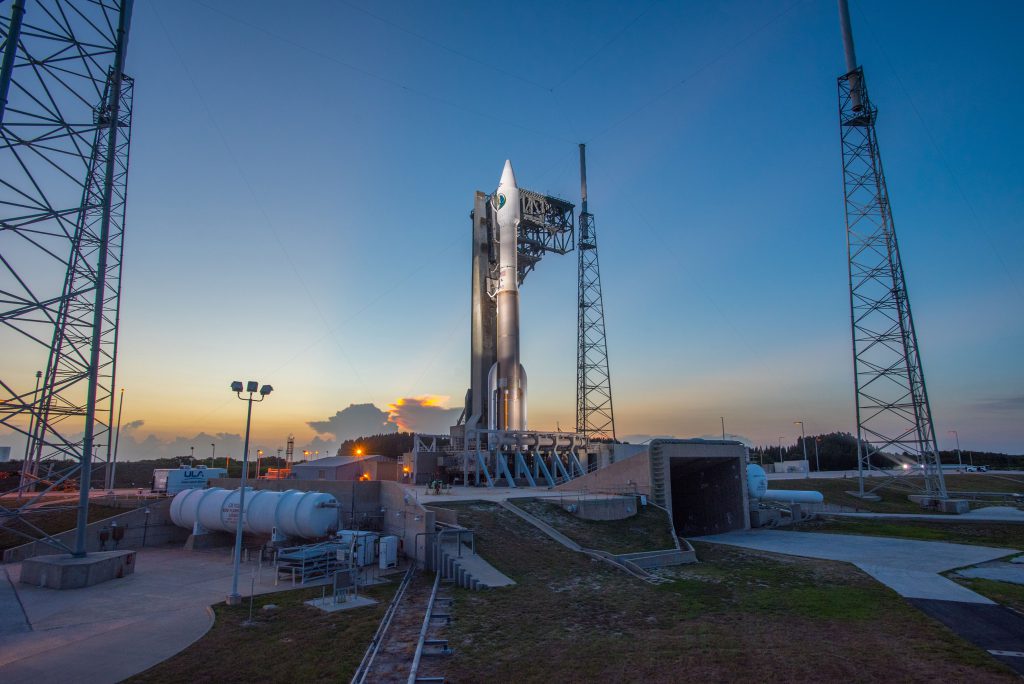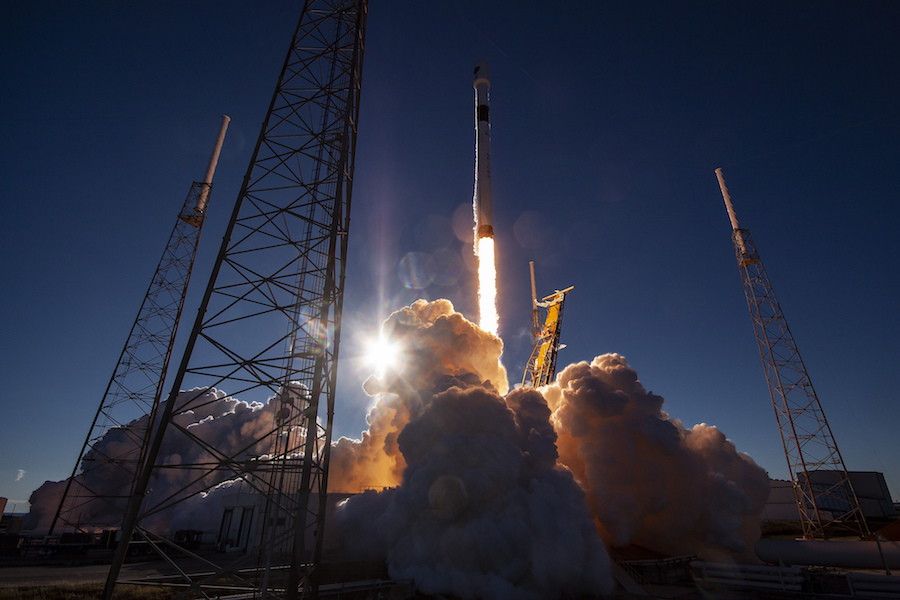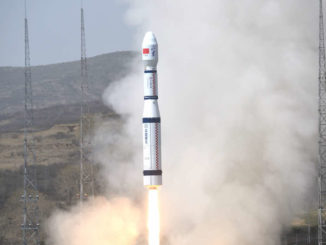
United Launch Alliance and SpaceX recently won contracts worth $739 million to send six missions into orbit for the U.S. military, and the Air Force has announced a new title for its flagship launcher program, dropping “expendable” from the name in a new era of reusable rockets.
The contracts announced in February by the Air Force’s Space and Missile Systems Center were split between ULA and SpaceX, rivals in the U.S. launch industry. ULA won deals for up to three launches worth $441.76 million, and the Air Force awarded SpaceX contracts worth $297 million, also for three missions.
Air Force and ULA officials confirmed to Spaceflight Now this week the configurations of the rockets assigned to the six military space missions.
The Air Force’s fifth Space Based Infrared System, or SBIRS, satellite will launch around March 2021 on an Atlas 5 rocket from Cape Canaveral, and the Air Force awarded an option for ULA’s Atlas 5 to launch the sixth SBIRS spacecraft in 2022. The SBIRS satellites host infrared sensors to detect plumes from missile launches, nuclear detonations, large explosions, wildfires and volcanic eruptions around the world, and their main purpose is providing early warning of an enemy attack on the U.S. homeland or allied nations.
The SBIRS GEO 5 and 6 satellites will launch toward positions in geostationary orbit more than 22,000 miles (nearly 36,000 kilometers) above the equator. The two Atlas 5 rockets will release the early warning payloads in elliptical transfer orbits, where the spacecraft will use on-board engines to boost themselves to their final operating locations.
ULA will use Atlas 5 rockets with four-meter-diameter payload fairings and two solid rocket boosters — configuration known as the Atlas 5-421 — on each of the SBIRS missions. The first three SBIRS satellites launched on Atlas 5-401 rockets, flying without any strap-on solid rocket motors, in 2011, 2013 and 2017. The identical SBIRS GEO 4 spacecraft launched in January 2018 on an Atlas 5-411, with a single booster mounted on the rocket’s first stage to add extra thrust, allowing the Atlas 5’s Centaur upper stage to deorbit itself back into Earth’s atmosphere.
The switch to the Atlas 5-411 rocket variant ensured the launch would not create unnecessary space debris, keeping with a U.S. military policy to deorbit spent rocket stages when possible at the end of their missions.
Officials did not say why the SBIRS GEO 5 and 6 satellites will launch aboard the more powerful Atlas 5-421 rocket.
The Air Force also selected ULA’s Atlas 5 for the launch of the classified Silent Barker space situational awareness payload, which is scheduled around March 2022, according to the Defense Department’s contract announcement. The military has released little information about Silent Barker, besides revealing that the program is a joint initiative between Air Force Space Command and the National Reconnaissance Office, which owns the U.S. government’s spy satellite fleet.
The Air force has launched several small space situational awareness satellites in recent years to detect, track and inspect other spacecraft in geostationary orbit, where most large communications satellites are located. Gen. John Raymond, commander of Air Force Space Command, told lawmakers in 2017 the joint Silent Barker program is “designed to meet the DoD and intelligence community needs to enable space protection.”
Silent Barker is expected to launch directly into an orbit roughly 26,000 miles (42,000 kilometers) over the equator, above the geostationary belt, according to data published in Air Force procurement documents. The most powerful Atlas 5 rocket variant — an Atlas 5-551 with five solid rocket boosters and a five-meter payload fairing — will launch the Silent Barker mission from Cape Canaveral, according to ULA.

SpaceX’s three launch contracts include a pair of Falcon 9 missions, and one flight using the company’s triple-core Falcon Heavy launcher.
The Falcon Heavy mission, codenamed AFSPC-44, is scheduled in late 2020 or early 2021 from pad 39A at NASA’s Kennedy Space Center in Florida. The Air Force has not identified the payloads on the AFSPC-44 mission, but documents released with the military’s request for proposals suggest the launch will loft at least two payloads in a circular orbit more than 26,000 miles above Earth, at an inclination of 5 degrees to the equator.
The AFSPC-44 mission is the second Falcon Heavy contract awarded to SpaceX through the Air Force’s national security launch competitions, following the AFSPC-52 satellite delivery contract announced in June 2018 for a liftoff in 2020.
The Air Force also selected SpaceX Falcon 9 rockets for a pair of missions in 2021 hauling National Reconnaissance Office spy satellites into lower orbits.
The NROL-85 mission will launch from Cape Canaveral, likely heading into orbit with a pair of naval surveillance satellites. The NROL-87 mission is set for launch from Vandenberg Air Force Base in California, and its payload remains a mystery.
ULA’s Atlas and Delta rocket families were the only launch vehicles certified to loft the U.S. government’s national security payloads until the SpaceX’s Falcon 9 became eligible to compete for military contracts in 2015.
With the two NRO rocket contracts announced last month, the Falcon 9 has won seven Air Force-managed launch competitions since becoming eligible for launching the military’s most critical satellites, and the Falcon Heavy has won two similar competitions since it was certified following its inaugural launch in February 2018.
The Air Force has now selected ULA’s Atlas 5 rocket for six missions since competitive procurements began. ULA has firm orders for at least three more Delta 4-Heavy rockets, ULA’s triple-core heavy-lifter, carrying NRO optical imaging satellites and electronic surveillance spacecraft into orbit through 2022. The Air Force has tentative deals with ULA covering two additional Delta 4-Heavy flights for the NRO through fiscal year 2024.
ULA plans to retire the Delta 4 rocket’s single-core configuration this year, and will eventually phase out the Atlas 5 and Delta 4-Heavy rockets in the 2020s after the company’s new Vulcan launcher is in service.
The Air Force wants two launch providers eligible to compete for national security space missions to ensure military payloads have a ride to space, even if one rocket family suffers a failure.
EELV program gets new name
The Air Force has also given a new name to the Evolved Expendable Launch Vehicle program, a multibillion initiative begun in the 1990s to fund and oversee the development and operations of the Atlas 5 and Delta 4 rockets now owned by ULA.
The Space and Missile Systems Center announced March 1 that the EELV program’s new name is the National Security Space Launch program, in response to language in the 2019 National Defense Authorization Act.
The EELV program had its origin in 1994, when Congress directed the Defense Department to develop a plan to modernize U.S. space launch capabilities. President Bill Clinton signed a directive assigning responsibility for expendable launchers to the military, spawning the government-funded EELV program that resulted in the Atlas 5 and Delta 4 rocket fleets developed by Lockheed Martin and Boeing.
Lockheed Martin and Boeing merged their launcher programs in 2006, forming the United Launch Alliance joint venture.
“As the NSSL program embarks on a new chapter making launch services more agile and effective for the warfighter, it honors over twenty-five years of EELV history,” said Col. Robert Bongiovi, director of SMC’s Launch Enterprise Directorate. “Twenty-five years later, the program boasts a remarkable legacy of the successful launches of 75 national security space missions, placing more than $50 billion of space warfighting assets on orbit.”

“As NSSL commences, it is focused steadfastly on the future as this is one of the most critical times in the national security space history,” Bongiovi said in a statement. “The program is committed to 100 percent mission success and providing the most innovative, flexible, and affordable services to meet national security space mission needs and maintain U.S. dominance in space.”
Proponents of reusing rocket boosters and engines say the practice can cut costs, resulting in less expensive access to space for military satellites, commercial payloads and science probes.
The Air Force has not launched a mission on a reused rocket, but that will change with a Falcon Heavy mission scheduled no earlier than June carrying cluster of small satellites into orbit for the military, NASA and other customers. The Air Force does not consider the Falcon Heavy launch this summer — designated Space Test Program-2, or STP-2 — as a critical national security space mission because its payload consists mainly of experimental satellites.
The Falcon Heavy launch on the STP-2 mission is expected to feature two reused side boosters and a new center core. The side boosters are slated to launch on a Falcon Heavy mission in April with the commercial Arabsat 6A communications satellite, then return to Cape Canaveral for landings before ground crews prepare the hardware for the STP-2 mission.
The Air Force has not confirmed any plans to utilize previously-flown stages on a national security space mission, a class of payloads which are built and launched with additional military oversight. Such missions include the GPS, NRO and AFSPC launches awarded to SpaceX’s Falcon 9 and Falcon Heavy rockets in competition with ULA.
But it is clear that times are changing.
The dropping of the “expendable” name from the EELV program office, SpaceX’s increased use of recovered rockets, and the Air Force’s funding of ULA’s Vulcan booster and Blue Origin’s New Glenn launcher — both of which are designed for some hardware recovery and reuse — suggest military officials see a future where recycling rockets will be the norm.
Email the author.
Follow Stephen Clark on Twitter: @StephenClark1.



